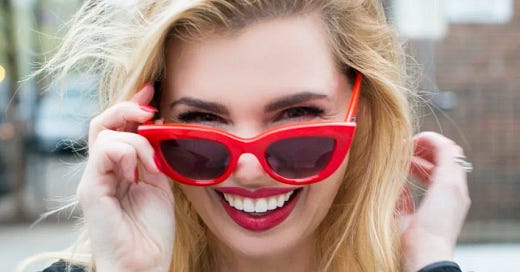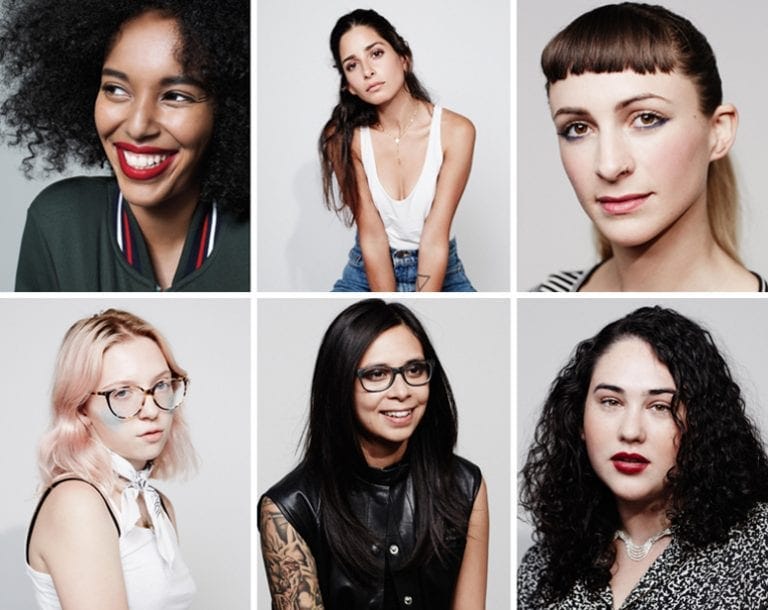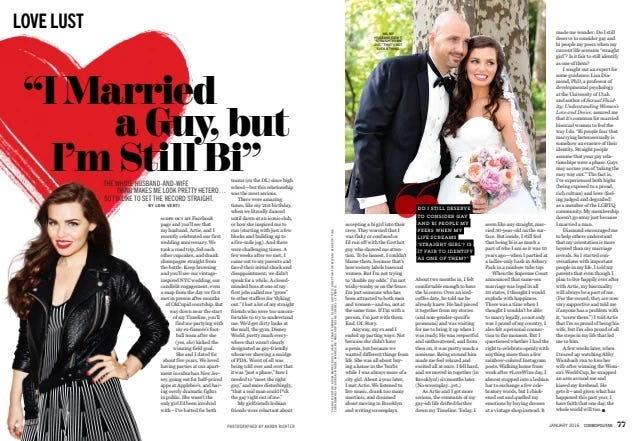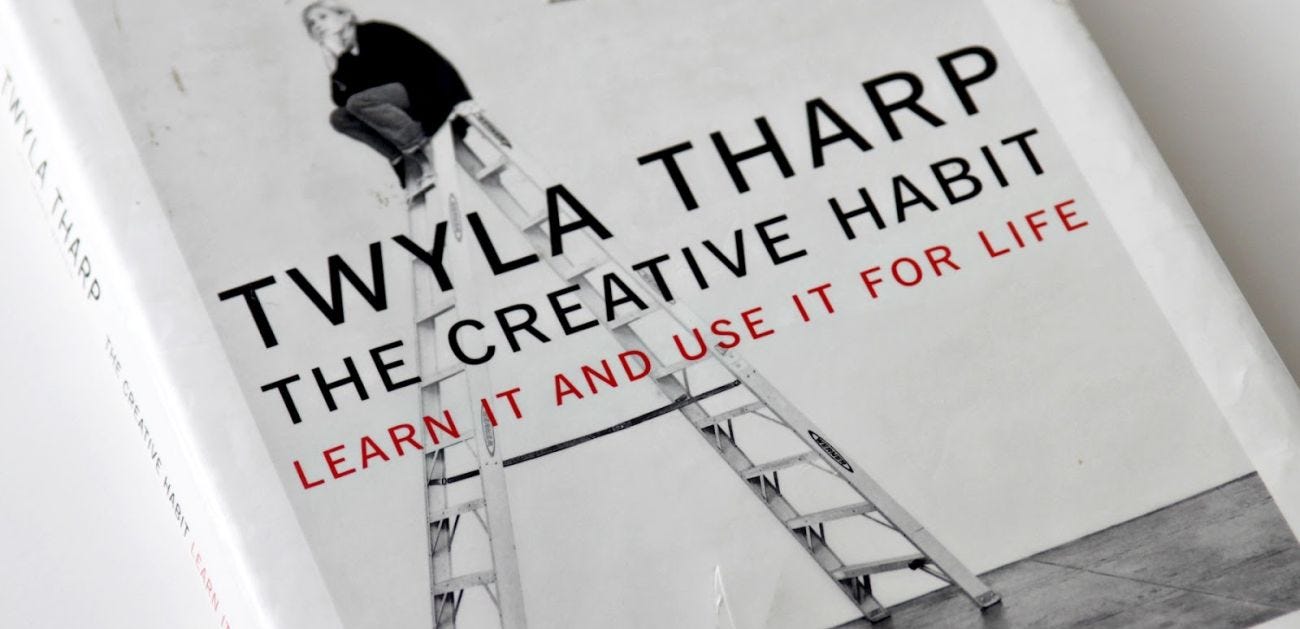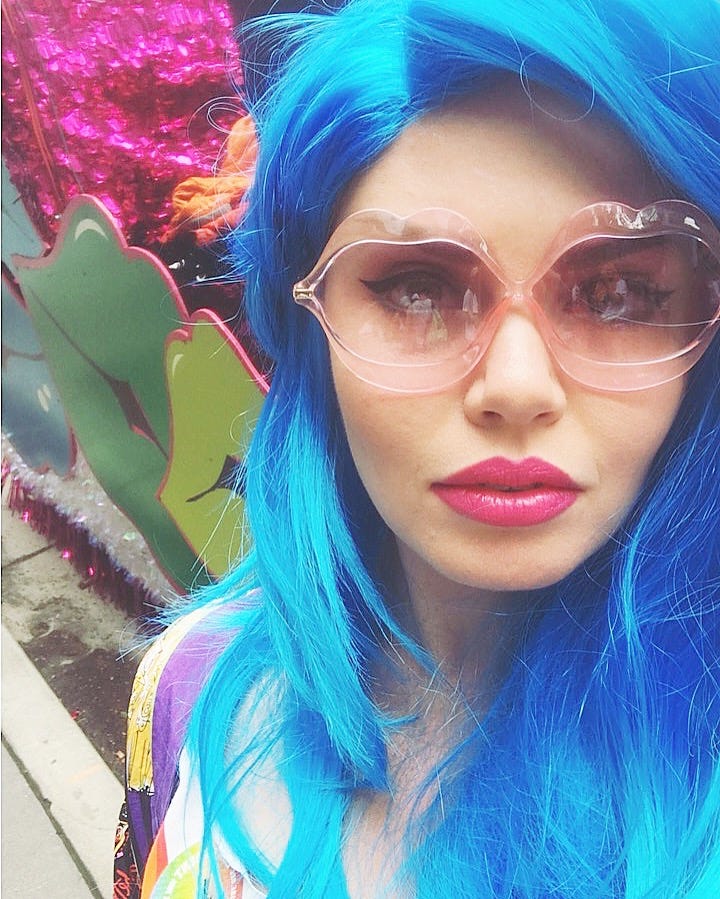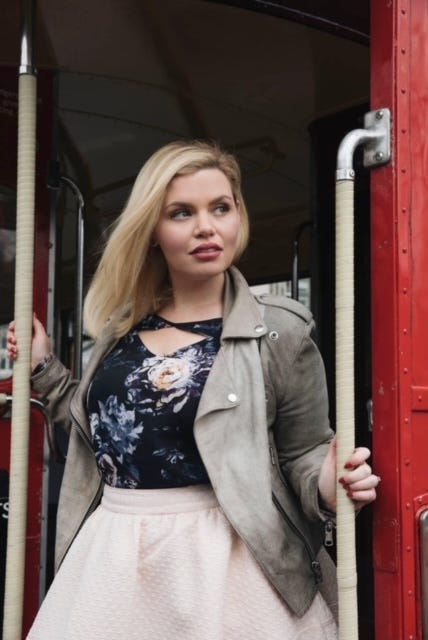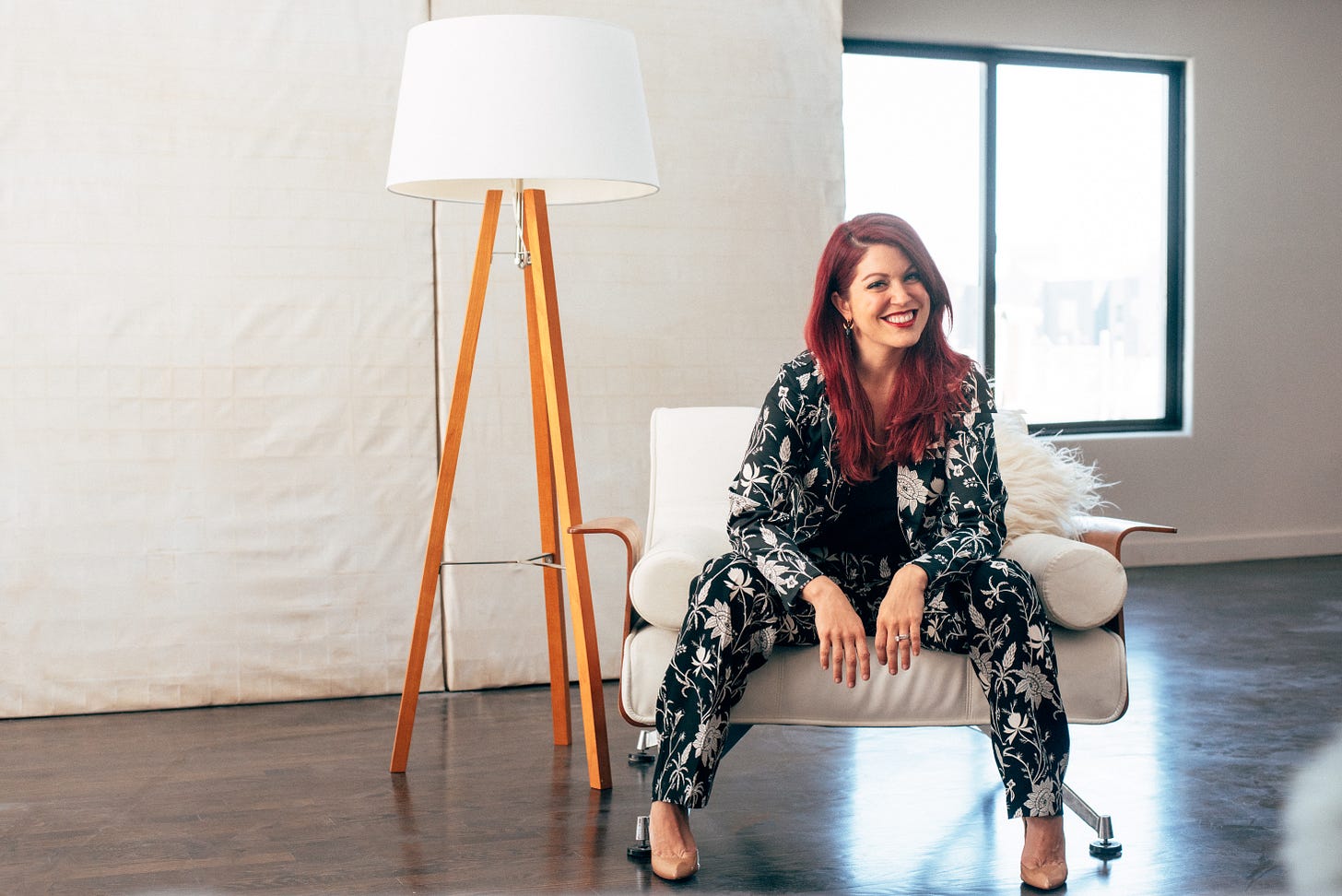👋, I’m Kimberly. I’ve been creating obsession-worthy brands for the past fifteen years. And now, I’m giving away my secrets every week in this newsletter.
Welcome to the Secrets of… Series — in which I’ve carefully designed a series of eleven thought-provoking questions to tease the most interesting and insightful information out of the best brand builders in the world.
This week, I sat down with Loni Venti — a stunning writer and beautiful soul who I had the extreme pleasure to work with on the rebranding of IPSY in 2017 when she was Creative Director there.
I was a bit nervous to interview Loni because she’s a professional interviewer. She grew up in the world of magazine journalism with her byline in Bustle, Allure, Glamour, Elle, Harper’s Bazaar, and Teen Vogue. But she made “interviewing the interviewer” as easy and delightful as it possibly could be.
Loni has a gift for listening and telling other people’s stories in the most compelling and compassionate ways possible. And I’m thrilled to shine the spotlight on her now so she can share the many insights from her personal and professional journey — and where the two often intersect.
Scroll below for Part 1 of this conversation.
Loni Venti is a writer, editor, and creative director based in Brooklyn, NY. You can find her words in Bustle, Allure, Glamour, Elle, Harper’s Bazaar, and Teen Vogue—to name a few. Currently, she is the Senior Manager of Editorial for Ulta Beauty. Some previous roles include Creative Director at IPSY and Senior Beauty Editor at Cosmopolitan. She has written about fashion, fitness, and relationships—but beauty will always have her heart.
1. How would you explain what you do to someone who has no idea?
I usually start by saying I'm a writer. At the core, that's what I do. If I were going to romance it more, I would say that I'm a storyteller. And ideally, if I'm doing my job well, I make people feel something.
Whether you’re a writer, a content creator, a marketer, or a social media executive — you're always trying to find a way to connect. Maybe it’s through an image, or maybe it’s through a word. Whatever it is, you’re always looking to find that door to open where you can tell your story.
What’s your secret to connecting with people?
#1: Have honest conversations
One of my secrets to a good interview is not sticking to my interview questions.
I do some research ahead of time, and I come in with a list of questions and topics. But I really pay attention to the nonverbal cues.
I notice when people give a short answer, and when they sort of ramble on. I notice when they ramble on excitedly, when their eyes light up, when their body language shifts, when you can tell that their heart starts pumping because you’re talking about something they care about — and then I keep pulling and pulling from there.
#2: Go into your memory bank
If it's a campaign for Mother's Day, for example, I think about all the “new mom conversations” that I've had with people. And I think about which “new mom conversations” aren't being addressed right now in the marketing or in the stories that brands and publishers are telling.
The secret here is paying attention to people — to what people talk about and to what people care about — and paying attention to what brands, publishers, and the other storytellers are missing.
This is how you can make sure that the right stories are being told and that more people feel recognized, seen, loved, valued, and appreciated.
#3: Don’t feel tied to a typical content calendar
For example, in the beauty world, people pay a lot of attention to Festival Season. That's a really big moment in beauty and fashion.
I'm not saying that I would never recommend addressing it. But I believe that you have to think long and hard about who's going to festivals — and what are the rest of the people doing at this time?
How does it make them feel if they're not going to festivals, and all of the stories and all of the content are only talking about festivals?
It makes them feel left out. It doesn't make them feel seen or heard.
Plus, when you’re not following the normal calendar, it can be a fun creative challenge. And sometimes it’s a challenge you need.
You can burn out on a category, especially if it's something that's already a part of your life. You can burn out on mom content, beauty content, women's lifestyle content, or fashion content — because it seems like you can't escape from it.
Today, if I could write a cool masculine grooming story that is not something that ever would apply to me… of course, I won't say “never,” because who knows? But at this point in my life, it wouldn't apply to my routine.
Writing that kind of story might be a fun creative escape. I like to think of it as a challenge.
2. One of my favorite quotes about branding is this one from Wally Olins:
Fundamentally, branding is a manifestation of the human condition. It is about belonging; belonging to a tribe, to a religion, to a family. Branding demonstrates that sense of belonging. It has this function for both people who are part of the same group and also for the people who don’t belong.
What brands have made you feel like you belong in your lifetime? These could be brands you belong with right now—or in the past (say, when you were a teenager).
I like that this quote mentions people who don't belong — because I know a lot of people who are writers and creative people who feel this way.
I've never really felt like I belonged per se. Now I try to own it and embrace it. But when I was younger, it was much harder to grapple with.
I don't think there's ever been a specific brand that made me say, "This is Loni Venti. I would buy everything that they make. I see myself in everything that they post."
But some brands have done something at specific moments in time that made me say, "Yes, I feel seen, and they're just doing it really right.”
Brand Moment #1:
Frida Mom’s Breastfeeding Commercial
Frida Mom showed a breastfeeding commercial during the Golden Globes, and it was one of the first times that a woman's breast was shown breastfeeding on television.
People sometimes shame moms for breastfeeding in public — and in general shame moms for the choices they make. But these are all natural things. All choices are equally valid. And many times, it isn't even a choice to breastfeed or not — your body can’t or your baby doesn’t want to.
The ad put all of the things that people place a lot of shame around in the postpartum stage front center — full spotlight. I have chills right now talking about it because it was so powerful for me.
Moms are so amazing, and we do so much even when all of the odds are stacked against us.
This moment of normalizing the less glamorous side made me feel seen in a way I'd never felt seen before. That’s why Frida Mom is always winning for me.
The campaign shows how sometimes you have to break the rules and push beyond what other people have done before to connect in a way that's meaningful and impactful.
And they freaking did it.
Brand Moment #2:
Old Navy’s Aidy Bryant Campaign
As a short and curvy “midsized” woman (TikTok says I'm midsize now, a size eight or ten 10), I have never felt comfortable in jeans.
I've never found a pair that fit me. I've never thought, "Oh, I can't wait to just throw on some comfy jeans!"
With Old Navy’s Aidy Brian campaign, she broke the fourth wall in a conversational way — where it felt like my friend who may have had a similar challenge finding jeans that made her feel amazing was saying, "We have jeans for you."
I couldn't get enough of the campaign.
I was just eating it up, because I thought, "Oh my gosh, these are my people! They understand my jeans struggle. I thought I was alone in the world with my jeans struggle. So thank you for that."
Brand Moment #3:
Milk Makeup Launch
When Milk Makeup launched, I was a few years into my beauty editor career.
I’ll start by saying that I'm so incredibly grateful for all those experiences and to everyone I worked with as a beauty editor. But I’ll also say that ten and fifteen years ago, the beauty world and the fashion world were not as accepting as they are today.
I was working in a space where we were constantly telling women to look hot for men; it was a very heteronormative, patriarchal ideal of conventional beauty.
I was constantly writing about that beauty ideal — every day, day in and day out. And no models would ever be bigger than a size four. That was my life.
And then I remember going to the brand launch for Milk Makeup.
They had this incredibly diverse cast of muses. There were nonbinary folks. There were plus-sized models. There was beauty in a way that had not been presented to me before.
It was beauty that I knew in my heart had existed. It was beauty that I could recognize in people around me and I could recognize in the world. But it was beauty that wasn't reflected in any media yet.
I always felt like Milk Makeup was very revolutionary in how it started presenting this beauty to the world.
And it spoke to me because I was just so exhausted with not feeling like enough — and with feeling like beauty was seen in such a singular way that did not reflect reality at all, and it was harmful to many people.
I was just starting to have this accountability and this existential crisis about it. And I went to Milk Beauty event and I saw what they were considering beauty, and I thought, "This is it!"
I feel the same way about Kulfi Beauty. I didn't realize, because of my privilege, the absence of South Asian beauty in the conversation about beauty.
I am just so freaking proud of Kulfi’s founder Priyanka Ganjoo, who I know from IPSY, and how she stepped up and said, "No one is talking about us. And the only times they do, it's incredibly problematic. So we are going to change the conversation. We are going change the narrative here."
The brand’s creative, the brand’s marketing, and everything they make is so, so good. I'm always using them as inspiration in my meetings.
What they're doing is incredible and so powerful and so important. It speaks to me as someone who feels like an outsider.
3. What event or interaction in your life has most shaped who you are today in your work?
Interaction That Shaped Me:
Writing at Cosmo
The time that I spent at Cosmo was the best training for learning how to tell stories and speak to an audience in a voice.
When I was there, the Cosmo voice was super streamlined throughout every story. It sounded like Cosmo on every single page. And I understood the importance of that quickly and how my continuing to work there was dependent on me being able to think in that voice as well as know how to pitch.
I don't want to say it was like boot camp because that might have a negative connotation. But it was the best training that I could possibly get.
I learned from the best editors and beauty minds. And I have to shout out Leah Wyar, who was my boss and mentor during my time at Cosmo. She is a force in the beauty, publishing, and content world. I also learned from the art and creative team. and I'm just so incredibly grateful and honored to have had that time there.
I learned a really solid foundation. Cosmo was like my grad school.
Today’s brands have to create content across so many channels, and many of them struggle to keep their voice consistent. What did they do at Cosmo to make the voice so consistent across everything?
Lots and lots of rounds of edits!
And they had a very high bar. They demanded and expected excellence — and nothing else was accepted. I don't mean that in an abusive way. I mean that in an encouraging and empowering way.
I was mostly working in print for the majority of the time that I was there, and print was a different world. A lot of time and thought and effort and energy went into the articles and many, many rounds of editing to get it right.
Today’s digital world is much faster. You have to create more and more and more content. People are writing two and three articles a day each, and there's no time to do it in that way.
I work with lots of teams right now where we're creating lots of digital content — and you get to a point where you say, "This is pretty good. Let's run with it."
There was no “pretty good” when I was working at Cosmo. It always had to be excellent. That's a big part of it.
There were also a lot of discussions and a lot of group brainstorms. We were constantly talking about it.
And we went to lots and lots of events where we were amongst the people who were the Cosmo readers and absorbing them.
Since you grew up in this amazing training ground of print — where you had the time for edits and every word mattered — how do you go about training your digital writers of today? Are you worried about them?
The short answer is I'm not worried.
Where some of the skills and tools that were handed to me may not be what the new crop of writers are getting, they have lots of other amazing tools. They will be able to rise to the occasion of what is needed at the time that it's needed for them.
Madman is fiction, but it's based on how they did marketing and how they told stories in the '50s and the '60s. And so many of the fundamentals are there.
The fundamental of what makes you a good storyteller never changes, but the mediums and the platforms do.
One of the teams that I'm working with right now — they're all in their first or second job, and they bring so many things to the table that I would never have thought of myself because they grew up in the digital world. They always had the internet. They always had social media.
I'm glad that I didn't have social media because I would have been embarrassed with the way I was in high school. But they always had it. So they have this innate understanding of how it works that I don't know if I ever will have.
Hopefully, I can pass the torch and show them what personally works for me. Then they can make it their own and create their magic with their personal experiences. They're super, super smart.
Also, Gen Z is the coolest generation ever. I'm so jealous that I'm not in Gen Z. They just get it. When I'm flipping through TikTok, I think, “How are you all geniuses at everything?”
This is a self help genius.
This is a cooking genius.
They're just geniuses.
Event That Shaped Me:
Having My Son
Having my son had a really big impact on who I am as a writer and marketer because it made me crave radical honesty.
Before, I wanted to be perfect. I wanted to look perfect. I wanted people to think I was perfect. I wanted people to see my career was perfect. I wanted them to think my apartment was perfect.
Even though it wasn’t.
And now that I've had this lifeshaking, turn-my-whole-world-upside-down and reprioritize-what-matters-to-me event, it changes all that.
I have never been perfect, and it is not helpful to me or to anyone else to pretend that I have been. Things that feel real are much more important to me — and that has shifted how I tell stories.
I think about the example of Festival Beauty. I don't mean to beat up on Festival Beauty, because it's really fun and creative. People should write about whatever they want.
But when I was thinking about Festival Beauty in the past, it might have been through the lens of, "Here's what all the cool girls are gonna be wearing at festivals."
And now I would think about how if you’re going to be out at a festival standing in line, feeling the sun on you, listening to the band that makes you come to life — this is the hairstyle you can wear so that you look great in your photos that you'll remember forever… but also you can have the best time and dance and not even think about it.
It's a perspective shift of what is real and what matters and what is important. This shift happened for me when I had Leo.
Truth That Shaped Me:
Being Bisexual
And then the other little thing that isn't a little thing at all — being an LGBTQ person, being bisexual, and being able to speak openly about that is really important.
Being an other myself helps remind me to always address the others who are reading my stories or consuming the content.
I've had a journey with coming to terms with it myself and with the people in my life who I love coming to terms with it for me.
It wasn't always easy.
And a lot of this journey has shaped how I think about telling stories — making sure everyone feels seen and loved and valued for who they are, no matter who they are.
4. What is the marketing-related book you would gift to someone who isn’t in marketing? And what is the non-marketing-related book that’s had the most impact on you as a marketer?
I have to give you a disclaimer:
I'm a messy reader. I have good intentions to read tons and tons of books. And I order them. And then I stack them in a pretty stack. I have lots of pretty stacks.
Usually how it happens is that I read a chapter, I get obsessed with it, I forget about it, and then I go back a year later.
I love reading. But being a mom, it's sort of like a pipe dream of me finishing a book.
My Business-Related Book #1:
Steal Like an Artist by Austin Kleon
My husband worked in marketing for UC Hastings when we lived in San Francisco, and his boss there gave this book to him. I stole it from him because the title sounded amazing.
It reminded me of the fact that there are no new ideas. There's just what you do with them.
I had a friend who would always talk about how if you don't honor the muse when she comes to you, she's going to leave you for somebody else.
Ultimately, there are all these ideas floating around that already are in the world. You just have to take one and make it relevant and make it yours and put your spin on it.
My Business-Related Book #2:
The Creative Habit by Twyla Tharp
Reading this book was the first time that I thought about being intentional about my creative process.
In the past, I would think, "Oh, I have writer's block. It's just not going to be a good writing day" or "I'm just not inspired right now."
Then I learned that I needed to have a process — and that I needed to build a plan to be inspired and tap into my most creative self.
My Non-Business-Related Book:
Untamed by Glennon Doyle
It's called Untamed because the book is her telling stories from her life — of things that happened that tamed her and things that happened that retaught her how to be untamed.
The stories are so relatable. There's a moment when she goes downstairs and asks her teenage kids and their friends, "Does anyone want anything to eat?"
The boys instantly say, "Yeah!"
But the girls all look at each other. Then, one of them decides, "We're fine."
This little moment shows how men can just be in their bodies, in themselves, and confidently want what they want.
But women have to worry, as young as twelve or thirteen, and ask, "Is what I want okay? Is it acceptable? Will I be judged? Let me go to the committee and see what the committee thinks about this and ultimately, I'll look to someone else to decide for me."
Some moments are much bigger and more life-changing, and some are that simple.
The whole time you're reading, you're thinking, "Yes! Yes!" and nodding your head the whole time — because it's so powerful and so relatable.
I also love Glennon Doyle’s We Can Do Hard Things podcast equally.
She and her sister Amanda talk honestly about things that people don't talk about that much. A lot of it is emotion — how to deal with other people and how to deal with your feelings — and it's really powerful.
I take so much of the podcast into my work in terms of managing all the different personalities.
When I’m working on a photo shoot, for example, there are so many different personalities on set and involved in the shoot. And recently on the podcast, they were talking about how people need to be helped differently.
Sometimes you think you're helping someone, but it is not helpful to them. You have to learn how to listen and understand people so that when you're working together, you're helping them in the way that they want and need to be helped.
5. You're getting put into the Brand Builders Hall of Fame. What do you want to be remembered for? And what do you wish would be forgotten?
My honest answer is that I hope I haven't created it yet.
I hope that I have something coming within the next six to twelve months, where I'll have an opportunity to resonate with people, make an impact, and give back to a community.
Campaign to Be Remembered For:
ISPY Pride
One thing that was very important to me when I was at IPSY was for us to have a float in Pride.
At IPSY, everything was about self expression. Their mission was to inspire individuals around the world to express their unique beauty. And IPSY had done little nods to Pride here and there previously. They weren't ignoring it by any means, but it also wasn't a huge celebration.
But what is more expressive than Pride? It's such a profound and huge celebration of self expression.
So I went completely offscript, off process, off everything.
I put a deck together and pitched it to my amazing manager at the time, Stephanie Lin. I talked about why I wanted IPSY to have a float in San Francisco Pride and how we were going to invite the community to march with us and have this big companywide celebration.
Stephanie was super supportive and loved it. Our CEO got on board. We had the budget.
There were a lot of sleepless nights. But at the end, we had a beautiful, sparkly rainbow — and giant lips everywhere. We had shirts. It was very, very epic.
I got to be on top of the float and see all the people of San Francisco and connect with the community in a real way.
To be there with them on the ground was a once-in-a-lifetime experience, and I'm very, very grateful for that opportunity.
Campaign to Be Forgotten:
WTF is a Merkin?
When I was at Cosmo, I wrote a story called “WTF is a Merkin?”
Are you familiar with what a merkin is, Kimberly?
I am. But I think you should explain it…
Mind you, this is Cosmo, okay?
Cosmo is a very, very sexpositive publication with a lot of sexy things going on. So even though I was a beauty editor, we still “went there” a lot of the time.
A merkin is a pubic wig, and it dates back to the Renaissance.
Now it's used as self-expression in the pubic area. So, for example, if you want to have hot pink heart-shaped pubic hair, and you do not have hair that naturally grows that way, you have the tool to do so.
The first page of the spread said “WTF is a Merkin?” in giant letters.
The story was a huge package about caring for your bikini area, waxing, shaving, letting it grow, and all of the options available to you. The topic was, at the time, very interesting and helpful to the Cosmo reader. It included a first-person tale of my first Brazilian.
And the reason that I would like to forget it is the experience I had showing the storuy at a job interview.
I was meeting with the CEO, who was a man.
He was flipping through my portfolio, and I had this story there — because so much research went into it.
I had researched and factchecked the entire history of pubic hair trends since the beginning of time. It was so much work, and I interviewed so many people. I wanted it in my portfolio to show how well I could research and build a package, because that's very important as a beauty editor.
But I didn't ever think that I would be in a meeting with a man who would see it and instead of just flipping past it or not wanting to talk about it would ask me, “Well, what the F is a merkin?
I said, “Oh, you don't know?”
He said, “No.”
Then I had to explain it.
And so that is why it is one that I would like to forget, Kimberly. Thank you for helping me remember.
Campaign to Be Forgotten:
IPSY Travel Beauty
The other one is a campaign I did that was all about travel beauty — getting inspired by different cities around the world.
We had amazing talent booked for it, but it was a huge logistical planning shoot because we were going to Paris and London. The talent, unfortunately, kept dropping out for various reasons.
So I had to sub in at the last minute as talent while I was in my first trimester and had really bad morning sickness.
I was running around Paris in 6-inch heels, full glam — and I'm chugging lemonade to curb my crazy stomach so that I wouldn't throw up. Classy stuff.
That's the other one that I'd like to forget.
The campaign itself ended up being great. The other talent was wonderful. And they pulled it all together very nicely.
But I decided that my modeling career was a one-and-done situation for me.
Read Part 2 of my interview with Loni in next week’s issue of The Branding Newsletter.
And if you’re finding this newsletter valuable, consider sharing it with friends, or subscribing if you aren’t already.
About Me
I help early-stage founders create the kind of brands that get customers so obsessed, they’ll do your advertising for you.
Based on my experience founding my own consumer brand, I developed The Branding Sprint—a uniquely collaborative, streamlined, and agile approach to brand creation.
Click here to learn more about The Branding Sprint, or schedule a call with me.

